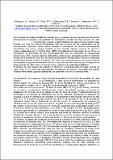Por favor, use este identificador para citar o enlazar a este item:
http://hdl.handle.net/10261/13189COMPARTIR / EXPORTAR:
 SHARE
BASE SHARE
BASE
|
|
| Visualizar otros formatos: MARC | Dublin Core | RDF | ORE | MODS | METS | DIDL | DATACITE | |

| Título: | Cambios en las comunidades bacterianas del rumen asociados al consumo de hojas jóvenes de roble (Quercus pyrenaica) y su posible relación con la aparición de intoxicaciones en ganado vacuno |
Otros títulos: | Changes in the rumen bacterial communities associated with the consumption of young oak (Quercus pyrenaica) leaves and their possible relationship with intoxications in cattle | Autor: | Belenguer, Álvaro CSIC ORCID ; Hervás, Gonzalo CSIC ORCID ; Doce, Raquel R. CSIC; Yáñez Ruiz, David R. CSIC ORCID; Santos Antón, Nuria CSIC ORCID ; Mantecón, Ángel R. CSIC ORCID ; Frutos, Pilar CSIC ORCID | Palabras clave: | Hydrolizable tannin Rumen bacteria Intoxication Molecular technique |
Fecha de publicación: | may-2009 | Editor: | Asociación Interprofesional para el Desarrollo Agrario | Citación: | XIII Jornadas sobre Producción Animal (AIDA), ITEA. Tomo I: 364-366 (2009) | Resumen: | [EN] Intoxication of grazing cattle occurs repeatedly when they consume large amounts of young oak (Quercus pyrenaica) leaves (OL), that are rich in hydrolysable tannins (HT). In order to study the effect of the administration of HT-rich OL on the rumen bacterial communities and investigate a possible relationship between these and the intoxications, three ruminally cannulated bulls were subjected to a severe feed restriction period, before receiving OL for 6 days. Then, they were offered grass hay for 12 more days. Rumen contents were sampled throughout the experiment and terminal restriction fragment polymorphism (tRFLP) were used to monitor the bacterial dynamics. Animal 1 was not intoxicated, whereas animals 2 and 3 showed acute signs of intoxication with the OL administration. However, animal 3 presented signs of recovery approximately one week after stopping the OL administration. The microbial profiles of animal 1 clustered separately from animals 2 and 3, except for the sample from animal 3 on day 18, when this animal was recovered. These results suggest that individual composition of the rumen microbiota might be a key factor in determining the effect of the consumption of HT-rich OL in grazing ruminants. | Descripción: | 3 págs, 2 figs.-- Ponencia presentada a las XIII Jornadas sobre Producción Animal (AIDA. Zaragoza, 12-13 de mayo de 2009). | URI: | http://hdl.handle.net/10261/13189 | ISSN: | 1130-6009 |
| Aparece en las colecciones: | (IGM) Artículos (EEZ) Artículos |
Ficheros en este ítem:
| Fichero | Descripción | Tamaño | Formato | |
|---|---|---|---|---|
| Belenguer et al_2009_AIDA.pdf | 397,35 kB | Adobe PDF |  Visualizar/Abrir |
CORE Recommender
Page view(s)
378
checked on 24-abr-2024
Download(s)
137
checked on 24-abr-2024
Google ScholarTM
Check
NOTA: Los ítems de Digital.CSIC están protegidos por copyright, con todos los derechos reservados, a menos que se indique lo contrario.
